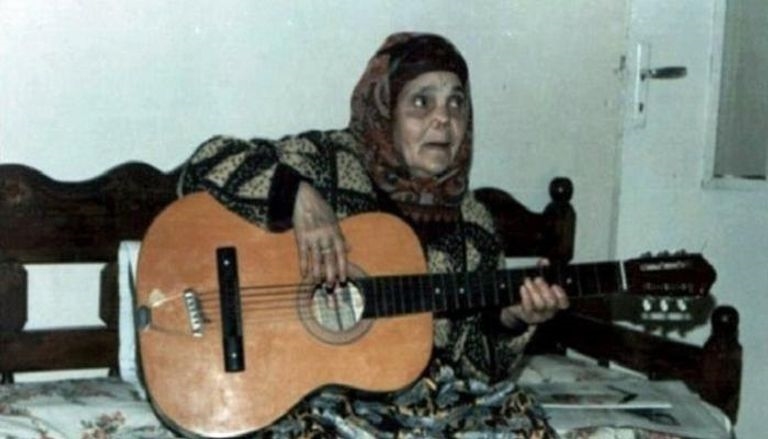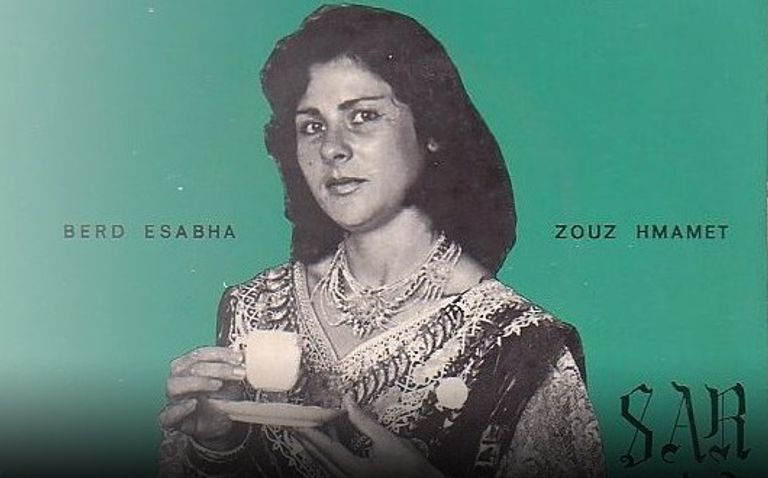Baggar Hadda...the lady of the Algerian Bedouin song who died in poverty

Baggar Hadda, the first Algerian artist to transfer Algerian art to the world, was called the legend of Bedouin song in Algeria, but her death was unfortunate.
Baggar Hadda, or as she is called in Algeria, “the doyenne of the Bedouin song” with the essential mountainous voice, is one of the first Algerian artists who brought authentic Algerian art out of the shell of the local and into the global.
The Algerian artist and singer, “Baggar Hadda,” was born in January 1920 in the village of “Aith Berber” Ouled Berber in the Souk Ahras Governorate, “640 km east of Algiers.” She was known as “Haddah El Khencha” because of the deformity on her nose.

She was unique, according to everyone who knew her closely, as she was the one who wrote and composed all of her songs that brought her fame to the world. She was also a poet and wrote poems about love and the Algerian revolution, and a good player on the traditional Algerian “kasbah” instrument, which resembles a flute. In addition to her skill in playing the tambourine in the Chawi-Amazigh style, or as it is called in Algeria, “the bandir.”
She was described as a complete artist despite her illiteracy and the circumstances of her poor family living under the yoke of French colonialism, which starved, displaced and killed people in all the villages and cities of Algeria.
Baggar Hadda was famous for performing the Bedouin song of the Chaouia Amazigh region (eastern Algeria). She was the only artist of her time, and the first Algerian woman to sing Bedouin songs and defy all her circumstances. In her words, she mixed the Algerian colloquial dialect with the Chaoui Amazigh dialect, with precise and committed words.

A truncated childhood
Baggar Hadda expressed an inner wound and pain that haunted her throughout her life in a number of her songs, including “I shook my eyes, they met me, mountains of Mashrouha,” meaning “I raised my eyes, they met me, mountains of Mashrouha,” (Mashrouha is an area in the Souk Ahras governorate), and the song “Mountains of Mashrouha, the heart is full and the liver is wounded.” That is, "In the mountains of Al-Mashrouha, the heart is full."
“Baggar Hadda” in these and other songs did not mean the life of poverty that she lived, but rather about a black point in her life that haunted her throughout her life.
Due to the old customs in her city, Baggar Haddah was forced by her father to marry at the age of 14 to an old sheikh. She found herself bearing the responsibility of a house and a husband who could barely speak. Poverty and the dominance of French colonialism increased her, and she went out like the women of her village to tend the sheep.

Nature discovers the sharp voice of a cow
Despite the melancholy of her story, which was subject to authoritarian customs and outdated customs, Baqqar Hadda’s departure to herd sheep made her spend her time “humming” and performing Bedouin “mawawil” of the Algerian Shawi style.
Baggar Hadda discovered over time that she had an artistic voice that could free her from her harsh circumstances and the pressures of her society’s customs, which considered a woman who sang to be a disgrace to her family and her region.
In one of her rare press interviews, she said: “Despite my love for Ibrahim (her second husband) very much, I loved to see what Algeria would be like, and in my small hut I sang my first song at night, the memory of which goes back to me standing in front of my father and his friends.”
A love story titled: A flute flirting with a voice
After the death of her husband, Baggar Hadda met the player of the “casaba” instrument, known in Algeria as “the butcher” and whose name is “Ibrahim.” A love relationship arose between them that ended in marriage, but it was outside the customs of her people and her region.
After she was met with her family’s rejection of Ibrahim and the idea of her singing, she decided to rebel against her family and run away with Ibrahim at the end of the thirties. Her love story was the reason for her writing and performing the song “Shake Your Eyes, Raham Shavo Fiya,” meaning “Raise Your Eyes... She Sees Me,” which was one of the most famous songs. Her songs were performed by a large number of Algerian artists.
In one of her press statements, Baggar Haddah said about that story: “The pleasure of escaping tempted me more than staying with a man I did not love. I was not reprehensible and my voice was too beautiful to be seen. They married me to an old man when I was 14 years old, and they asked me to accept my fate, but Ibrahim The butcher who loved me without seeing me sent his love messages to me through his playing. I understood them. A flute was flirting with a voice. My voice rose as high as a peacock’s feathers to show that the colors varied to delight the viewer. I met him on a dark night, far from the wedding venue where I was singing. I asked him: What? He brought you here, so the answer is: What brought you here? Since then, I have not asked any questions because he understood the signs of my song as I understood the signs of his flute. Doesn’t love begin with signs as a first test for the lover?
Baggar Hadda explodes her voice locally and globally
After her marriage to Ibrahim Al-Qassab, Baggar Hadda graduated with her art from local wedding parties to wide fame that no Algerian artist could have dreamed of at that time.
She traveled with her husband to France, and there the doors of success opened for her, as she performed many concerts in a number of French cities, especially those that were aware of the presence of Algerian immigrants, and from the rest of the North African population, including Paris, Lyon, Marseille, Strasbourg, and others. However, the concerts It was not recorded or broadcast.
At the end of the 1950s, Baggar Hadda signed the first contract for an Algerian artist with the French company Edition Star, to record a large number of Bedouin songs derived from the Chaoui-Amazigh character.
Despite her fame and success that went beyond the borders of Algeria, she was the only Algerian artist who did not record songs with the Algerian radio or television after independence, even though the Algerian radio was broadcasting some of her songs, although the reason remains a mystery.
The Algerian revolution... in the heart and on the tongue
"The Lady of the Bedouin and Shawian Song" was famous in Algeria for her powerful revolutionary songs, especially since she lived through the Algerian revolution after her return from France in the 1950s. Her voice rang out with masterpieces in which she glorified the Algerian revolution and inherited the spirit of its martyrs, including "The Soldier Khoya," "O Jebel Boukhadra," “Damo Sayeh” (His Blood Is Bleeding), in which I mourned the martyr of the Algerian liberation revolution, Abbas Laghar.
After Algeria's independence in 1962, Baggar Hadda moved between various Algerian villages and countrysides to perform huge concerts, and became famous as an artist at weddings and parties of senior officials in Algeria at the time.
Marginalization and poverty...and death
No one knows how the life of the artist Baggar Hadda turned from the lights of fame to the darkness of a basement in which she lived for the rest of her life. She did not receive media and artistic attention as happened with the rest of the Algerian artists after the country’s independence.
Baggar Hadda, whose fame extended to Europe, was hosted by state television only twice in the late seventies and in 1992. The year 1988 was the beginning of the artist’s bad luck, as it was the year in which her husband Ibrahim died, and with him the musical band of which he was a member broke up.

Baggar Hadda found herself alone, and returned to the city of Souk Ahras, where she lived in a hut, then left for Annaba Governorate (eastern Algeria), where she spent her last days in one room in a building, similar to a basement.
The artist sold all her simple furniture and the jewelry she owned in order to eat and resist the life of poverty that opened her eyes to her, and her fate wanted her to close her eyes to the life of poverty itself, and she died alone in her small room in September 2000, and her neighbors did not discover her death until several days had passed. A number of her neighbors confirmed that she died of disease and hunger.

A great artistic legacy
Despite her death in poverty, Baggar Hadda left a priceless artistic legacy, enriching the Algerian cultural and artistic stock with hundreds of Shawian Bedouin songs.
In honor of her spirit and to restore her respect after her death, a number of Algerian artists repeated Baggar Hadda’s songs, including Cheba Yamina, Slimane El Qalmi, Houria Aichi, Ismail El Qatari, and others.

The play “Haddah Ya Haddah”…the lady of the theater restores respect to the Badawi lady
The Algerian theater lady, the late artist Makio Sakina, known as “Sonia,” restored the honor of the late artist Baggar Hadda, through a play she directed, and behind it, she wanted to honor the artist and restore her respect.
The play “Hadda Ya Hadda,” written by writer Jalal Khashab, sheds light on Baggar Hadda’s struggle in her life, and her quest to achieve her dream of becoming an icon of Bedouin Chaoui singing in Algeria.

The play began with Hadda's childhood and her love of singing, then her marriage at an early age to an old sheikh against her will, then her meeting with the player of the traditional instrument, the "qasaba", at one of the wedding parties she was hosting, and her escape with him after she decided to rebel against the unjust traditions imposed by her village.

Then the scenario of the play moves to the artist’s entry into the world of stardom and fame, with songs that she performs accompanied by her husband, who always accompanies her and has the flute-like “qasaba” instrument in his hand. She focuses on the bright side of her life, her artistic balance, and her love for her country and freedom.

Source : websites

